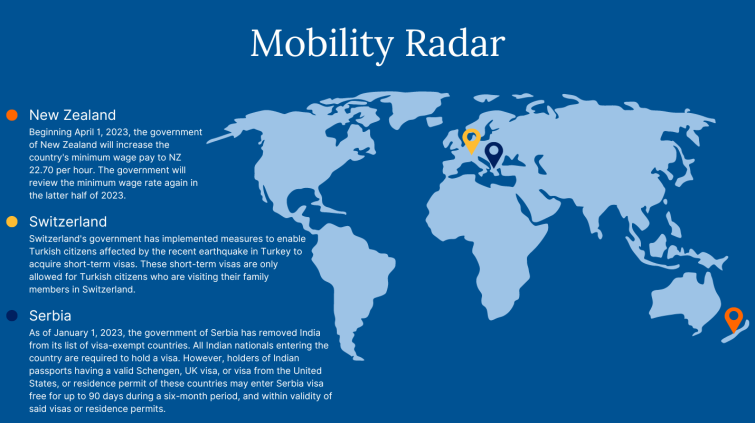CapRelo Insider: 23 Febuary 2023

SUBSCRIBE TO THE INSIDER NEWSLETTER
Something Just For You
The chances of most companies switching back to the pre-pandemic days of requiring in-office attendance five days a week are slim. With Millennials being the largest generation in the workforce in 2022, it’s likely that remote work, or remote work options, are here to stay. A recent Forbes article noted that Millennials won’t even consider a job offer if it doesn’t allow the option for hybrid work.
So, what does that mean for the future of work environments and expectations? As a global mobility manager, to maintain your team’s success and productivity levels, you may have to loosen the reins and identify new ways to hold employees accountable. Here are a few points to consider when leading a remote team (source):
- Understand common work-from-home challenges: Patience and understanding of employees’ surroundings and mental well-being are vital to establishing a successful remote team. Whether or not to require cameras on for every meeting or considering collaboration tools to improve employee engagement are factors to consider. Ideally, managers will be able to accommodate individual employee needs in many ways without sacrificing the team’s morale.
- Set clear remote work productivity standards: Establishing clear productivity standards within your team or across the organization can prevent burnout and help identify needs for additional training. Consult with your remote employees and ensure that everyone is on the same page when it comes to meeting productivity goals.
- Follow up with remote employees regularly: One-on-one calls aren’t just meant to monitor productivity, they can be used to keep employees motivated and engaged. Scheduling one-on-one calls with your remote employees – whether daily, weekly, bi-weekly, or whatever fits the need – can be an opportunity for you to understand how your employee is doing overall, or how best to address their professional development.
Latest Insights
Air-Freight Costs Down, Availability Up in 2023
After skyrocketing prices throughout 2021, the air-freight market began stabilizing in the closing months of last year. A combination of decreased demand and increased capacity is now pointing toward an attractive, lower-cost option for household goods shipments throughout 2023.
Air-freight surged at the height of the pandemic, as companies sought to avoid congestion at global ports. The conflict in Ukraine, and the overall decrease in the global economy, applied additional pressure on the market. These factors strained the supply chain, shooting prices (and shipping delays) to historical highs. In the following months, however, several factors began changing the situation: ports began to clear making ocean shipments viable again, airline capacity expanded, and diversification of shipping options through new competitors drove costs down.
Impact: For 2023’s household goods and freight-forwarding needs, air cargo is poised to become a more affordable option than it has been in years. With added capacity and competitiveness, this can be a consideration for lowering program costs overall.
Sources: Shippers regain buying power as air cargo fundamentals shift | Supply Chain Dive
IATA – Air Cargo Demand Softens in November
Far East Housing Market Report
Relo Network Asia has released their report on market conditions in 15 nations throughout Asia. While Asian markets have shown some signs of returning to pre-pandemic conditions, housing availability and international school placements remain extremely limited, and market prices across the board have remained high. The report can be a helpful barometer in planning global assignments in each country. Some of the highlights include:
- Cambodia – The past couple of years have seen Cambodia become one of the regions’ fastest-growing economies, with tourism up and the availability of expatriate services stable.
- China – With a post-COVID-lockdown strategy for 2023, the expectation is for lower availability of goods and services with higher accompanying prices.
- Japan – Property availability is low, and sharply limited spaces for international schools have resulted in long waiting lists. This situation is expected to continue through the first half of 2023.
- Indonesia – Demand for housing and furniture rental is high. Spaces for international schools are dwindling, but this has not impacted fees at present.
- Korea – Waiting lists for new car rentals can range from 6-12 months, and 3-4 weeks for used cars. Property availability is low and demand is high.
- Myanmar – Relocation is not recommended unless accompanied by a private security detail, given the crime rates and political instability.
- Philippines – A high influx of foreign arrivals has pressured the housing market, driving up costs.
- Singapore – Some stabilization of the market has occurred, though availability remains low and prices are high. Tenants paying fees to the realtors is now a common feature.
- Taiwan – There is high demand for rental properties, and high prices as a result. Negotiation fees are commonly equal to half a month’s rent.
- Vietnam– The local supply chain for goods and services has improved, and new housing construction has resulted in greater availability and stable prices, though furniture rental is scarce.
For the full report, see here.
U.S. Housing Market Faces Continued Challenges
In the U.S., interest rates in January fell from record-high prices last year, though market projections remain highly uncertain. Inventory has remained limited, and new home construction dropped for the fifth consecutive month in January. This low amount of inventory is not expected to resolve in 2023. Fears of a recession, coupled with high inflation and interest rates, have exacerbated buyer concerns. The net effect is that prices haven’t dropped enough to encourage new home purchases.
Source: Housing Market Predictions For 2023: Will Home Prices Drop? – Forbes Advisor
UK Businesses Call for Expansion of Overseas Work Visas
The British Chambers of Commerce (BCC) and the Confederation of British Industry have announced a demand for more overseas visas to fill job vacancies in the UK. This announcement comes as skill shortages continue. This has heightened the need for the UK government to expand the Shortage Occupations List allowing companies to attract overseas talent. According to the Office for National Statistics (ONS), the estimated number of vacancies in January 2023 was 1.13 million, with unemployment figures at a record-low 3.7%.
Jonathan Boys, senior labor market economist at the Chartered Institute of Personnel and Development (CIPD), commented: “At just 3.7 percent, unemployment remains low so fewer people are available and looking for work. When candidates are in short supply and even bumper pay rises can’t compete with inflation, employers need to consider the whole package they offer to staff.”
Impact: Combined with high inflation and total vacancies, there is a real need for UK companies to attract overseas talent. The upcoming budget provides opportunities for the government to address workforce shortages and accompanying challenges, such as the need to expand childcare, update the Shortage Occupations List, and make employer health support a non-taxable benefit. In turn, businesses should implement flexible work policies that offer more opportunities for employee training.
For more information on this or how CapRelo can help update your policies, reach out to one of our experts here.
Takeaways From the 2023 World Economic Forum
The annual World Economic Forum (WEF) was held in Davos, Switzerland on January 16-20th. Government and business leaders from 130 countries attended the summit, which had as its theme “Cooperation in a Fragmented World.” The WEF identified numerous global risks that all industries, including global mobility, may face in the next two years, but there is a light at the end of the tunnel. Some of the key takeaways include:
- The global economic outlook: The future health of the global economy was top of mind for many leaders in Davos. The forum’s first day began with the Chief Economists’ Outlook leaving those feeling cautious about the state and future of the global economy. The overall tone in Davos was one of concern but glimmered with the hope that leaders will avoid being too optimistic and too pessimistic in order to collaborate and keep the global economy in the best interest of all.
- Tackling the climate crisis: Discussions were held on the urgent action needed to handle the current energy crisis and environmental challenges. This included steps to reduce carbon emissions and reduce the effects of climate change during this period of global energy transition. To meet formal 2030 targets, it was proposed that more sustainable infrastructure be used as well.
- Addressing the future of work: Calls for the importance of reskilling to prepare the current and future workforces for many transitions were stressed, as workers continue to leave their jobs in a growing global economic crisis. There were discussions on the need for a new social contract allowing new opportunities for investing in education, skills, and healthcare, which can lay the groundwork for improved social mobility and economies.
For the full forum overview, click here.
Mobility Radar
CapRelo’s Mobility Radar is your added bonus of trends to keep an eye on. We’ve detected important global mobility updates in China, Canada, and Indonesia. For more information, be sure to subscribe to our monthly newsletter, CapRelo Insider.



